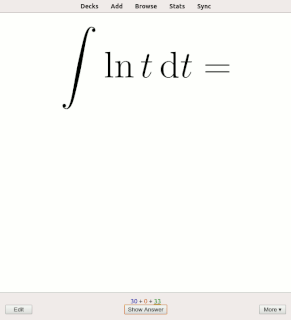
Educational psychology is the branch of psychology concerned with the scientific study of human learning. The study of learning processes, from both cognitive and behavioral perspectives, allows researchers to understand individual differences in intelligence, cognitive development, affect, motivation, self-regulation, and self-concept, as well as their role in learning. The field of educational psychology relies heavily on quantitative methods, including testing and measurement, to enhance educational activities related to instructional design, classroom management, and assessment, which serve to facilitate learning processes in various educational settings across the lifespan.

Learning theory describes how students receive, process, and retain knowledge during learning. Cognitive, emotional, and environmental influences, as well as prior experience, all play a part in how understanding, or a world view, is acquired or changed and knowledge and skills retained.
Instructional scaffolding is the support given to a student by an instructor throughout the learning process. This support is specifically tailored to each student; this instructional approach allows students to experience student-centered learning, which tends to facilitate more efficient learning than teacher-centered learning. This learning process promotes a deeper level of learning than many other common teaching strategies.

In psychology, cognitivism is a theoretical framework for understanding the mind that gained credence in the 1950s. The movement was a response to behaviorism, which cognitivists said neglected to explain cognition. Cognitive psychology derived its name from the Latin cognoscere, referring to knowing and information, thus cognitive psychology is an information-processing psychology derived in part from earlier traditions of the investigation of thought and problem solving.

The picture superiority effect refers to the phenomenon in which pictures and images are more likely to be remembered than are words. This effect has been demonstrated in numerous experiments using different methods. It is based on the notion that "human memory is extremely sensitive to the symbolic modality of presentation of event information". Explanations for the picture superiority effect are not concrete and are still being debated.

The testing effect suggests long-term memory is increased when some of the learning period is devoted to retrieving information from memory. It is different from more general practice effect, defined in the APA Dictionary of Psychology as "any change or improvement that results from practice or repetition of task items or activities."
Situated cognition is a theory that posits that knowing is inseparable from doing by arguing that all knowledge is situated in activity bound to social, cultural and physical contexts.

Constructivism is a theory in education that recognizes learners construct new understandings and knowledge, integrating with what they already know. This includes knowledge gained prior to entering school. It is associated with various philosophical positions, particularly in epistemology as well as ontology, politics, and ethics. The origin of the theory is also linked to Jean Piaget's theory of cognitive development.
In cognitive psychology, cognitive load refers to the used amount of working memory resources. There are three types of cognitive load: intrinsic cognitive load is the effort associated with a specific topic; extraneous cognitive load refers to the way information or tasks are presented to a learner; and germane cognitive load refers to the work put into creating a permanent store of knowledge.

Reading comprehension is the ability to process text, understand its meaning, and to integrate with what the reader already knows. Fundamental skills required in efficient reading comprehension are knowing meaning of words, ability to understand meaning of a word from discourse context, ability to follow organization of passage and to identify antecedents and references in it, ability to draw inferences from a passage about its contents, ability to identify the main thought of a passage, ability to answer questions answered in a passage, ability to recognize the literary devices or propositional structures used in a passage and determine its tone, to understand the situational mood conveyed for assertions, questioning, commanding, refraining etc. and finally ability to determine writer's purpose, intent and point of view, and draw inferences about the writer (discourse-semantics).
Self-regulated learning (SRL) is one of the domains of self-regulation, and is aligned most closely with educational aims. Broadly speaking, it refers to learning that is guided by metacognition, strategic action, and motivation to learn. A self-regulated learner "monitors, directs, and regulates actions toward goals of information acquisition, expanding expertise, and self-improvement”. In particular, self-regulated learners are cognizant of their academic strengths and weaknesses, and they have a repertoire of strategies they appropriately apply to tackle the day-to-day challenges of academic tasks. These learners hold incremental beliefs about intelligence and attribute their successes or failures to factors within their control.
Ann Lesley Brown (1943–1999) was an educational psychologist who developed methods for teaching children to be better learners. Her interest in the human memory brought Brown to focus on active memory strategies that would help enhance human memory and developmental differences in memory tasks. Her realization that children's learning difficulties often stem from an inability to use metacognitive strategies such as summarizing led to profound advances in educational psychology theory and teaching practices.

Discovery learning is a technique of inquiry-based learning and is considered a constructivist based approach to education. It is also referred to as problem-based learning, experiential learning and 21st century learning. It is supported by the work of learning theorists and psychologists Jean Piaget, Jerome Bruner, and Seymour Papert.
E-learning theory describes the cognitive science principles of effective multimedia learning using electronic educational technology.
The split-attention effect is a learning effect inherent within some poorly designed instructional materials. It is apparent when the same modality is used for various types of information within the same display. Users must split their attention between the materials, for example, an image and text, to understand the information being conveyed. The split-attention effect can occur physically through visual and auditory splits and temporally when time distances two pieces of information that should be connected.
The worked-example effect is a learning effect predicted by cognitive load theory. Specifically, it refers to the learning effect observed when worked examples are used as part of instruction, compared to other instructional techniques such as problem-solving and discovery learning. According to Sweller: "The worked example effect is the best known and most widely studied of the cognitive load effects".
The modality effect is a term used in experimental psychology, most often in the fields dealing with memory and learning, to refer to how learner performance depends on the presentation mode of studied items.
The expertise reversal effect refers to the reversal of the effectiveness of instructional techniques on learners with differing levels of prior knowledge. The primary recommendation that stems from the expertise reversal effect is that instructional design methods need to be adjusted as learners acquire more knowledge in a specific domain. Expertise is described as "the ability to perform fluently in a specific class of tasks."

A pedagogical agent is a concept borrowed from computer science and artificial intelligence and applied to education, usually as part of an intelligent tutoring system (ITS). It is a simulated human-like interface between the learner and the content, in an educational environment. A pedagogical agent is designed to model the type of interactions between a student and another person. Mabanza and de Wet define it as "a character enacted by a computer that interacts with the user in a socially engaging manner". A pedagogical agent can be assigned different roles in the learning environment, such as tutor or co-learner, depending on the desired purpose of the agent. "A tutor agent plays the role of a teacher, while a co-learner agent plays the role of a learning companion".
Danielle S. McNamara is an educational researcher known for her theoretical and empirical work with reading comprehension and the development of game-based literacy technologies. She is Professor of Psychology and Senior Research Scientist at Arizona State University. She has previously held positions at University of Memphis, Old Dominion University, and University of Colorado, Boulder.









